The impacts of rhetorical schema on English majors’ listening comprehension in academic situations at ho chi minh city university of technology and education
Listening is a basic language skill which involves the interaction of diverse factors affecting learners’ listening comprehension. Learners often encounter various difficulties in listening to an oral text with a little knowledge of the reasons why it occurs. Moreover, teachers mainly pay more attention to it as a product rather than as a process. Also, the factors about listening strategies have been under-Researched although they play a significant role in guiding learners through what to listen to and how to listen to it effectively. This study sought to investigate the effects of rhetorical schema including note-taking and four listening strategies, and the extent to which students change as regards strategy use and listening achievement in academic settings. Forty second-year EFL students from the two listening classes, one treated as the experimental group (EG) and the other as the control group (CG), at the Faculty of Foreign Languages of the Ho Chi Minh City University of Technology and Education (HCM UTE) were invited to participate in the study. Data were collected in the form of a questionnaire administered to EG and listening tests of IELTS part 4 taken by both groups. The findings indicate that EG students are more open to use the strategies introduced, so rhetorical schema positively enhance their listening comprehension. Notably, the scores of the rank high - distinction - appeared for the first time albeit its small percentage in EG. Students also express significant changes in their attitudes towards rhetorical strategies in terms of their awareness of its importance, frequent use, and confidence in listening to lectures in the future
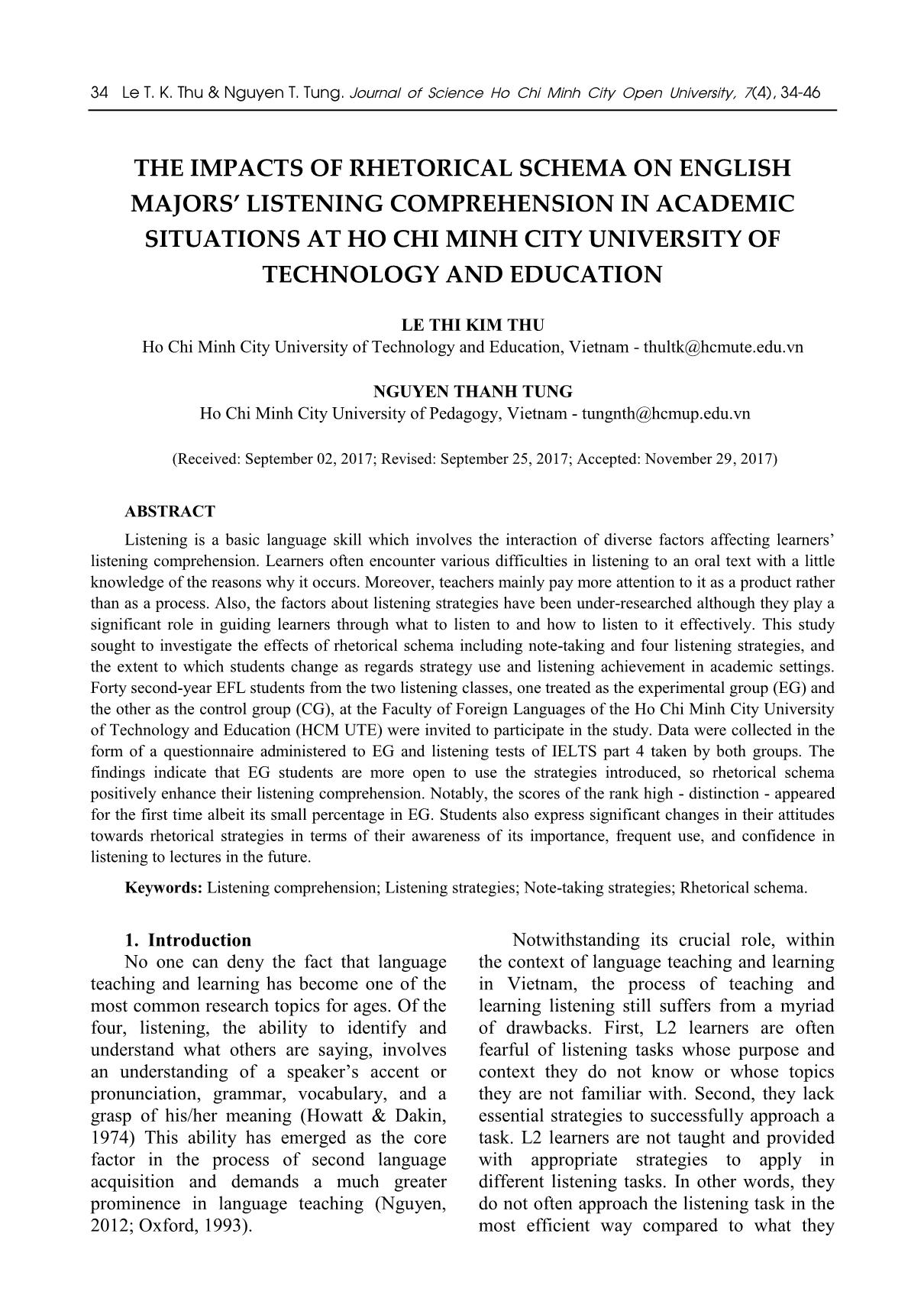
Trang 1
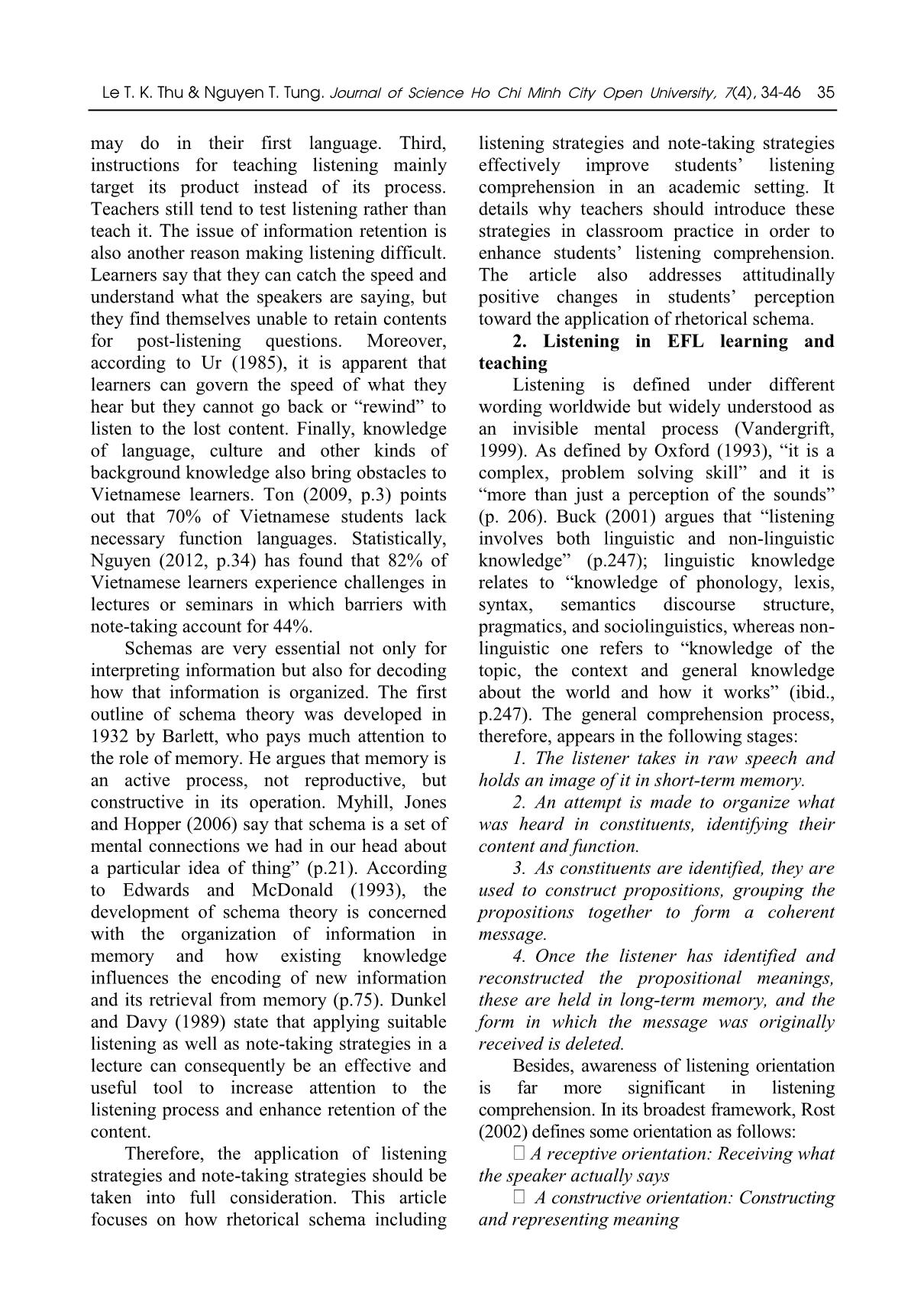
Trang 2

Trang 3
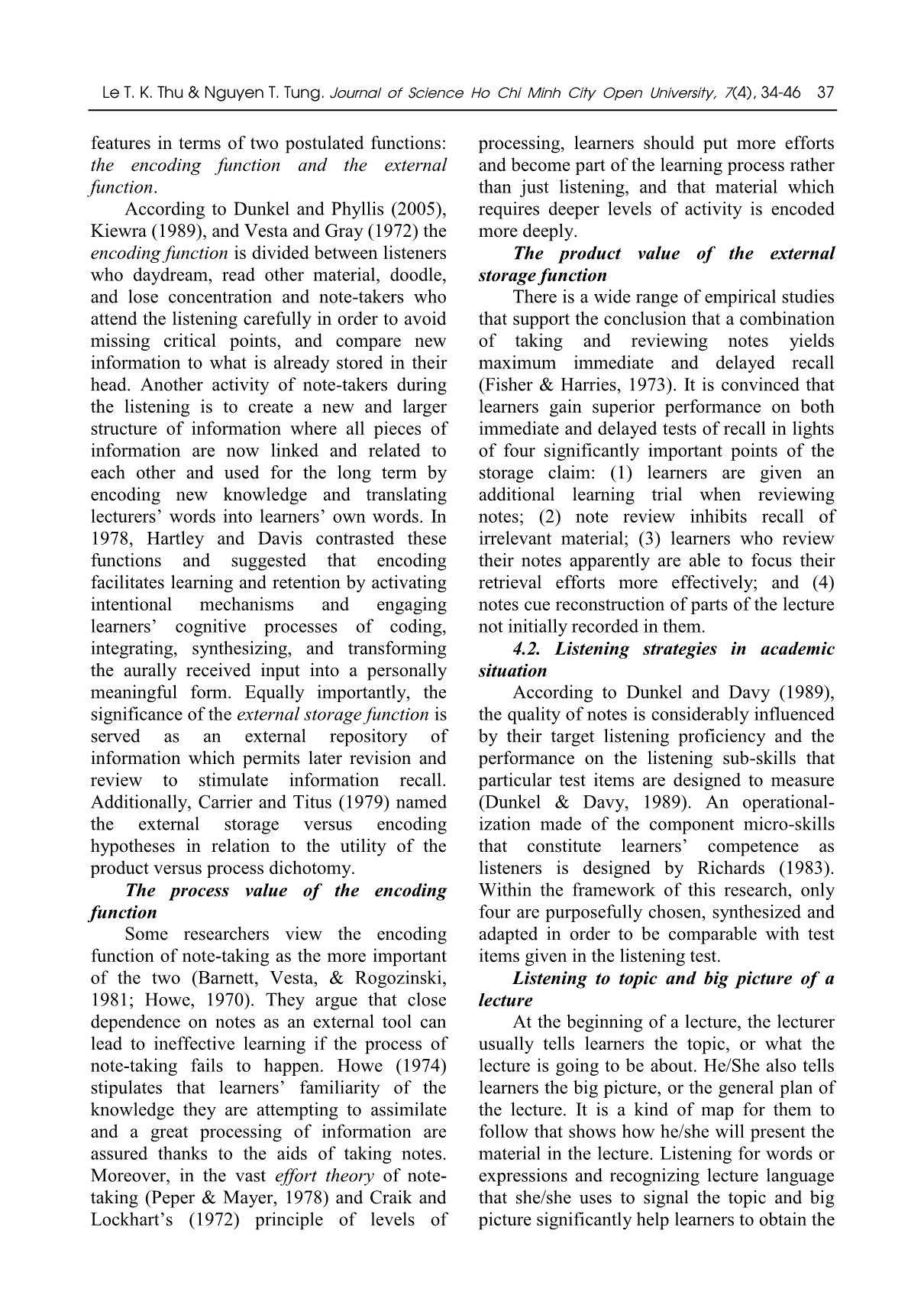
Trang 4
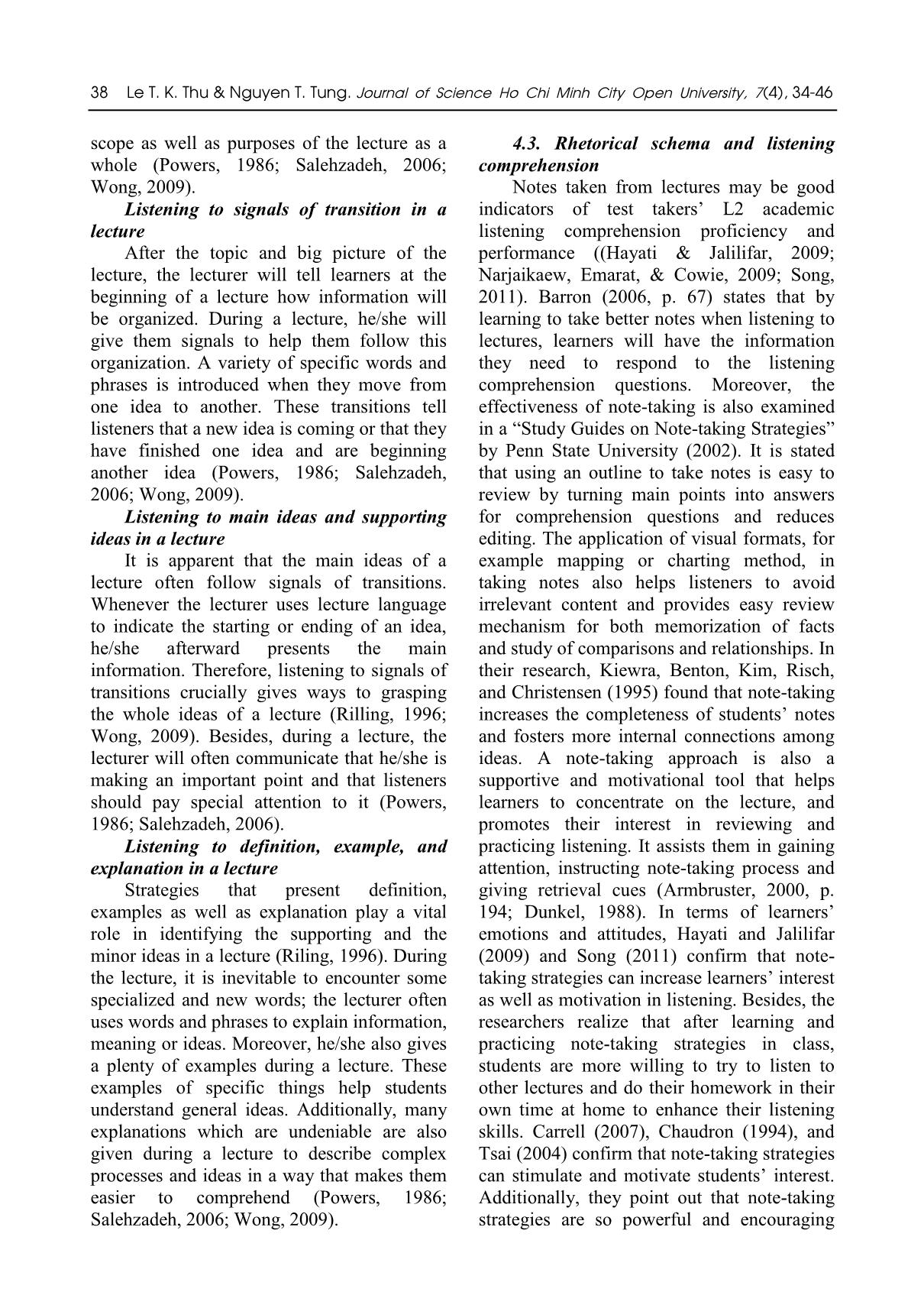
Trang 5
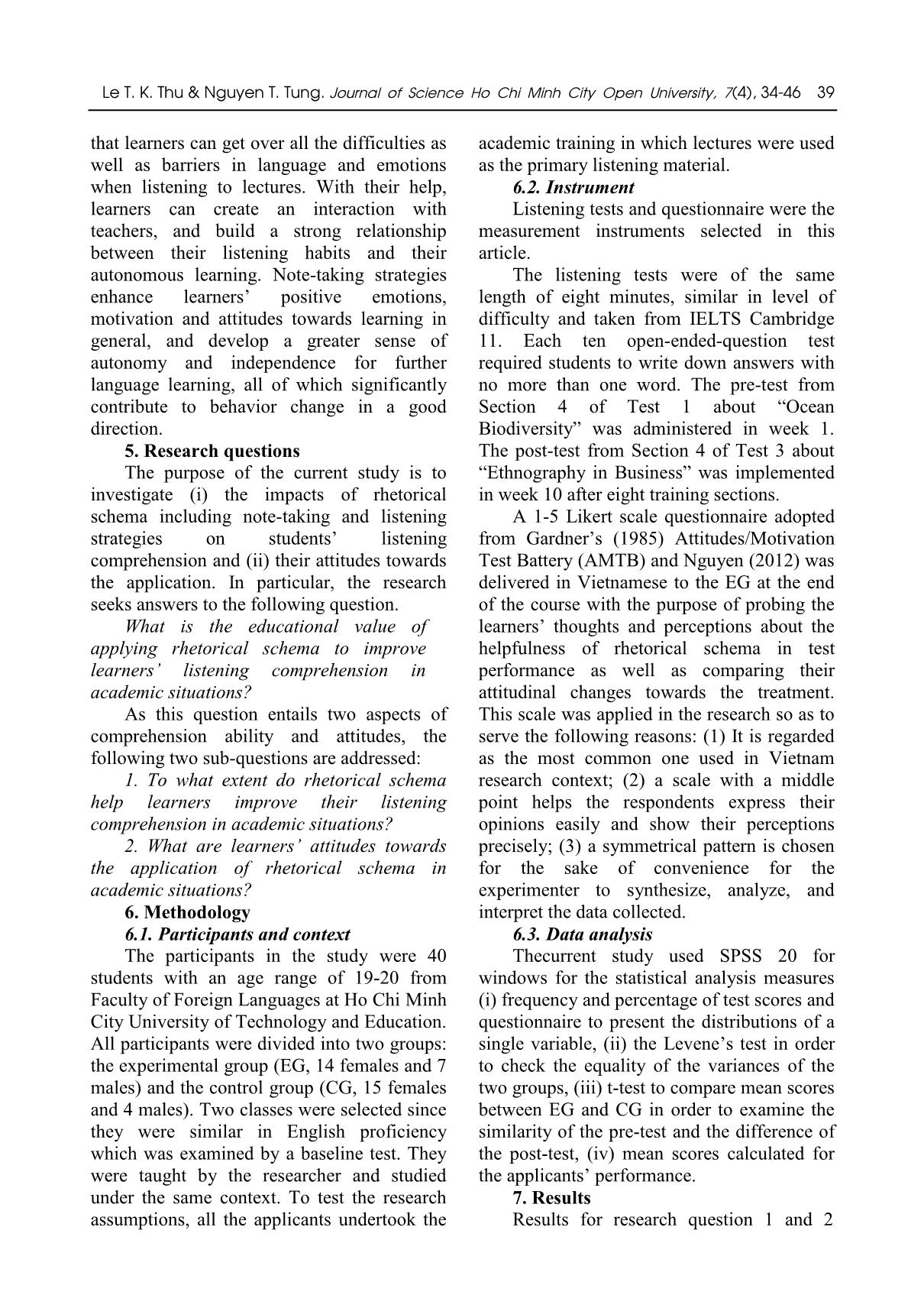
Trang 6
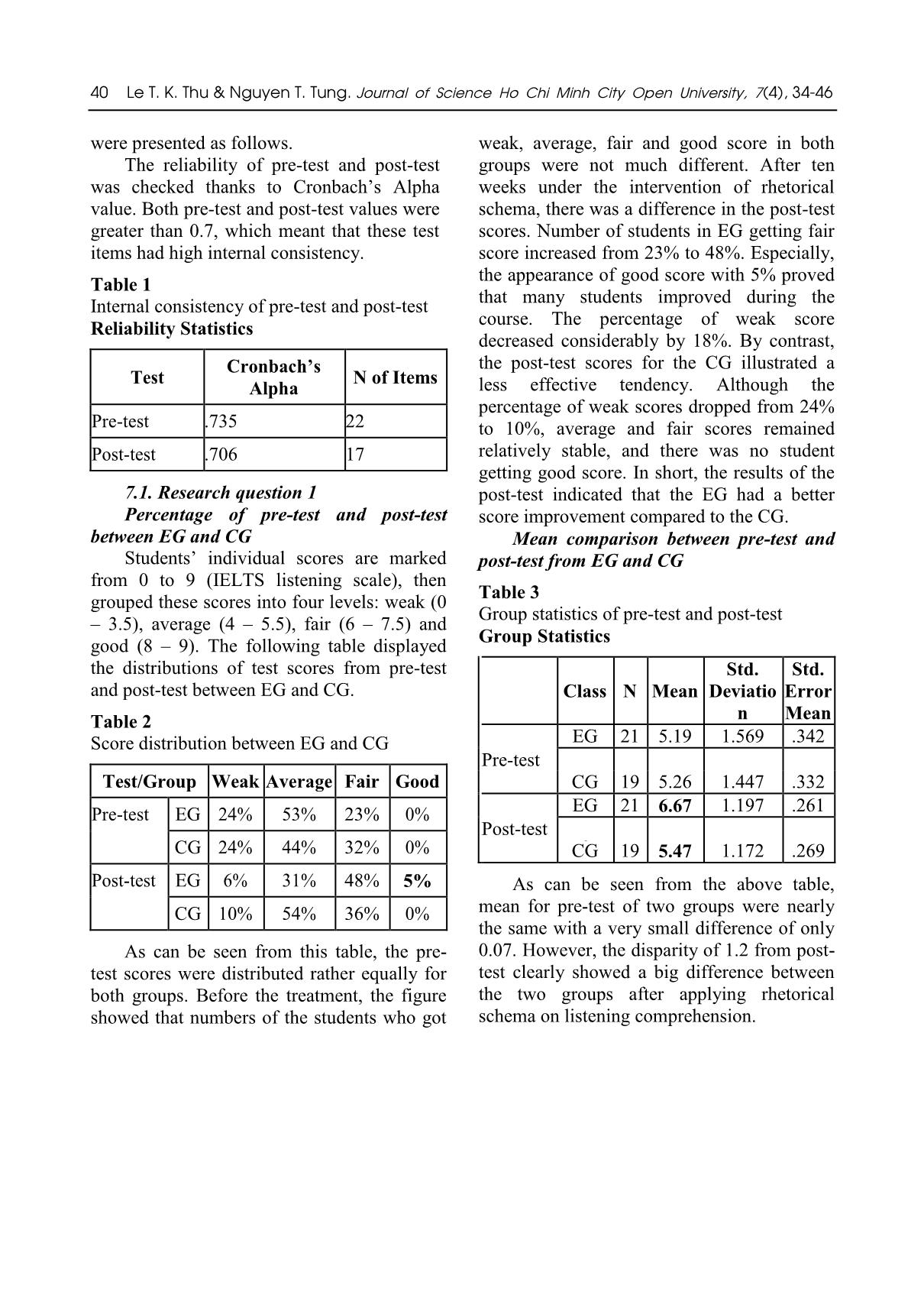
Trang 7
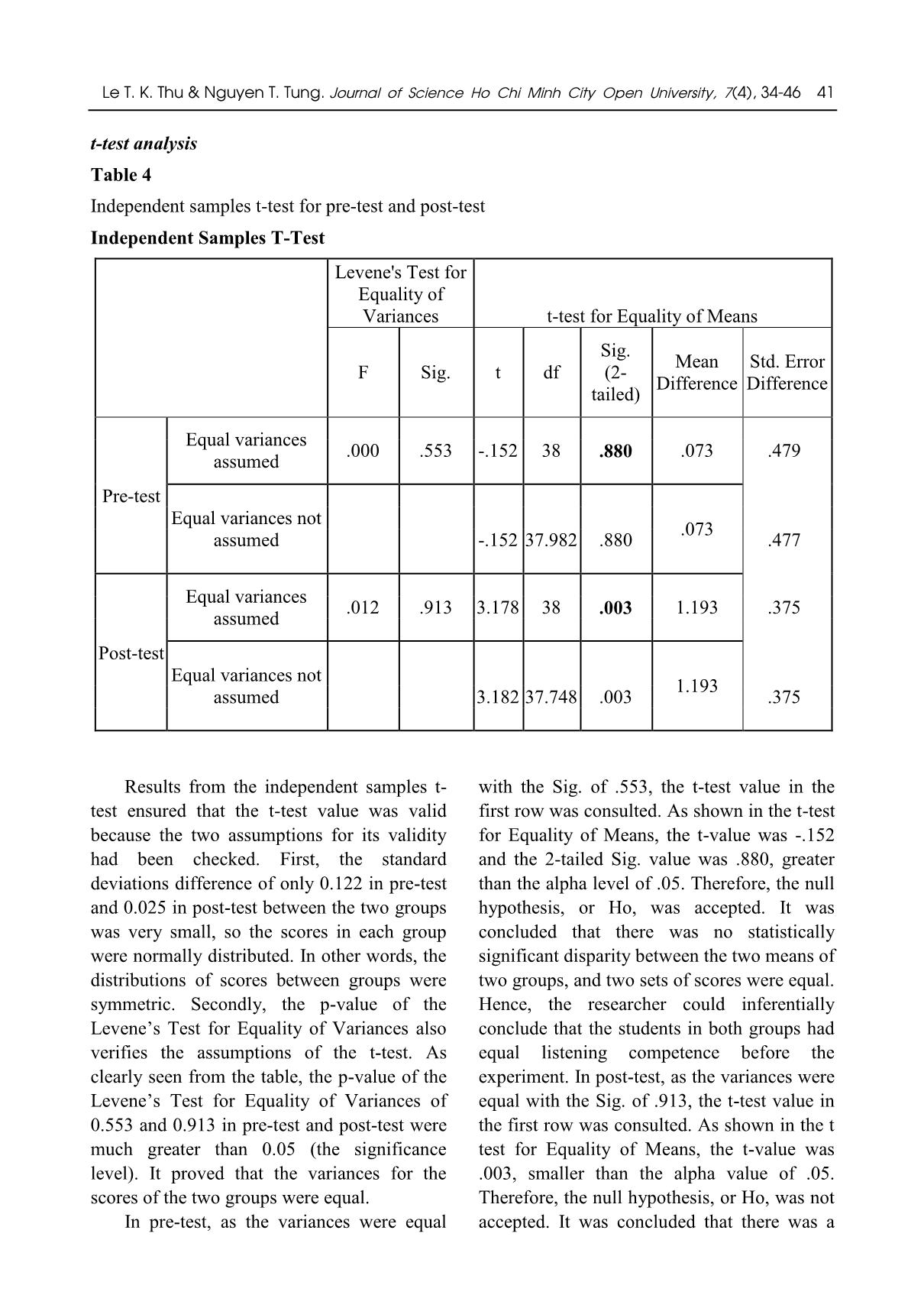
Trang 8
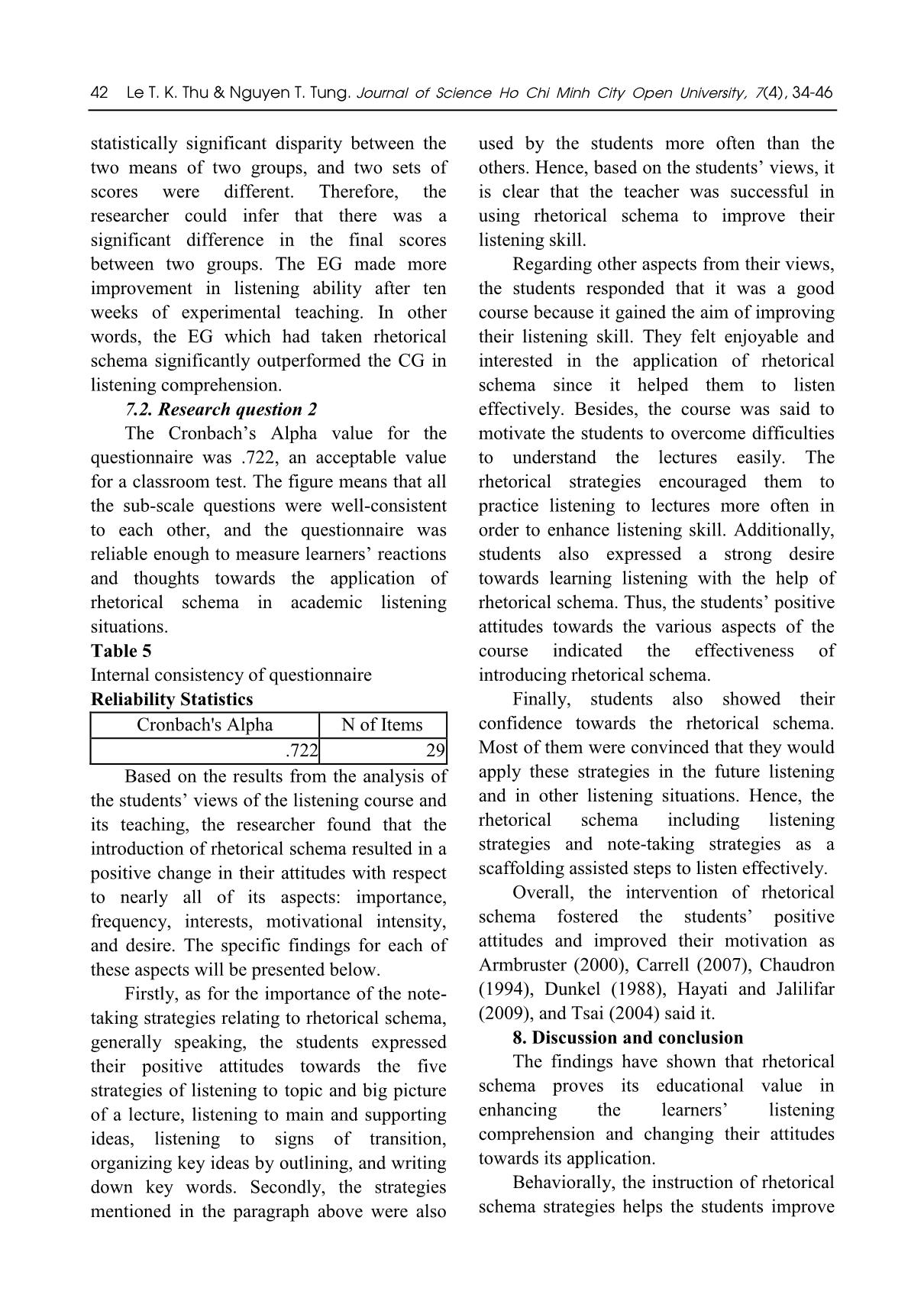
Trang 9
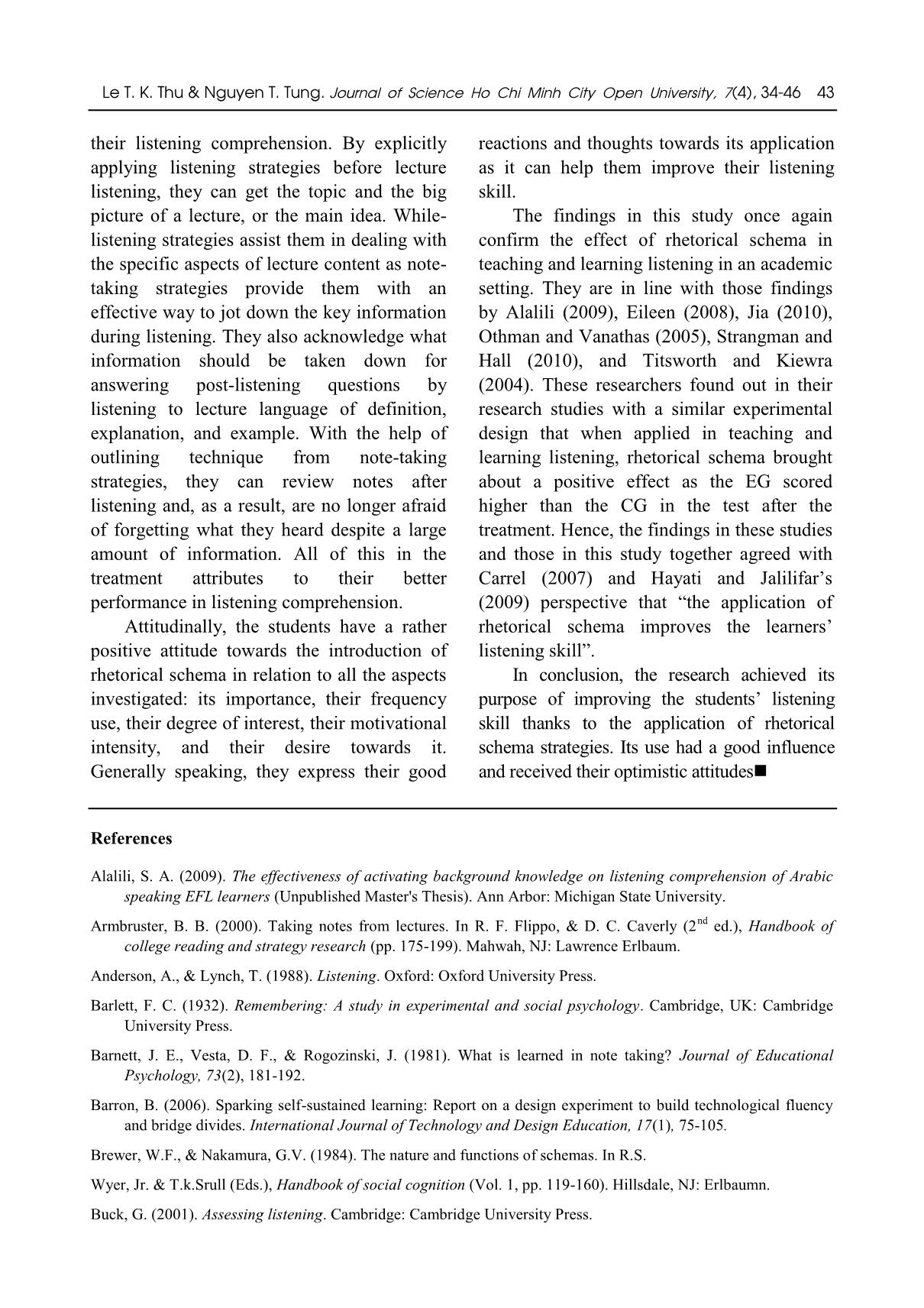
Trang 10
Tải về để xem bản đầy đủ
Tóm tắt nội dung tài liệu: The impacts of rhetorical schema on English majors’ listening comprehension in academic situations at ho chi minh city university of technology and education
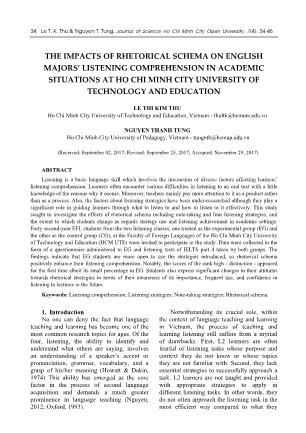
34 Le T. K. Thu & Nguyen T. Tung. Journal of Science Ho Chi Minh City Open University, 7(4), 34-46 THE IMPACTS OF RHETORICAL SCHEMA ON ENGLISH MAJORS’ LISTENING COMPREHENSION IN ACADEMIC SITUATIONS AT HO CHI MINH CITY UNIVERSITY OF TECHNOLOGY AND EDUCATION LE THI KIM THU Ho Chi Minh City University of Technology and Education, Vietnam - thultk@hcmute.edu.vn NGUYEN THANH TUNG Ho Chi Minh City University of Pedagogy, Vietnam - tungnth@hcmup.edu.vn (Received: September 02, 2017; Revised: September 25, 2017; Accepted: November 29, 2017) ABSTRACT Listening is a basic language skill which involves the interaction of diverse factors affecting learners’ listening comprehension. Learners often encounter various difficulties in listening to an oral text with a little knowledge of the reasons why it occurs. Moreover, teachers mainly pay more attention to it as a product rather than as a process. Also, the factors about listening strategies have been under-researched although they play a significant role in guiding learners through what to listen to and how to listen to it effectively. This study sought to investigate the effects of rhetorical schema including note-taking and four listening strategies, and the extent to which students change as regards strategy use and listening achievement in academic settings. Forty second-year EFL students from the two listening classes, one treated as the experimental group (EG) and the other as the control group (CG), at the Faculty of Foreign Languages of the Ho Chi Minh City University of Technology and Education (HCM UTE) were invited to participate in the study. Data were collected in the form of a questionnaire administered to EG and listening tests of IELTS part 4 taken by both groups. The findings indicate that EG students are more open to use the strategies introduced, so rhetorical schema positively enhance their listening comprehension. Notably, the scores of the rank high - distinction - appeared for the first time albeit its small percentage in EG. Students also express significant changes in their attitudes towards rhetorical strategies in terms of their awareness of its importance, frequent use, and confidence in listening to lectures in the future. Keywords: Listening comprehension; Listening strategies; Note-taking strategies; Rhetorical schema. 1. Introduction No one can deny the fact that language teaching and learning has become one of the most common research topics for ages. Of the four, listening, the ability to identify and understand what others are saying, involves an understanding of a speaker’s accent or pronunciation, grammar, vocabulary, and a grasp of his/her meaning (Howatt & Dakin, 1974) This ability has emerged as the core factor in the process of second language acquisition and demands a much greater prominence in language teaching (Nguyen, 2012; Oxford, 1993). Notwithstanding its crucial role, within the context of language teaching and learning in Vietnam, the process of teaching and learning listening still suffers from a myriad of drawbacks. First, L2 learners are often fearful of listening tasks whose purpose and context they do not know or whose topics they are not familiar with. Second, they lack essential strategies to successfully approach a task. L2 learners are not taught and provided with appropriate strategies to apply in different listening tasks. In other words, they do not often approach the listening task in the most efficient way compared to what they Le T. K. Thu & Nguyen T. Tung. Journal of Science Ho Chi Minh City Open University, 7(4), 34-46 35 may do in their first language. Third, instructions for teaching listening mainly target its product instead of its process. Teachers still tend to test listening rather than teach it. The issue of information retention is also another reason making listening difficult. Learners say that they can catch the speed and understand what the speakers are saying, but they find themselves unable to retain contents for post-listening questions. Moreover, according to Ur (1985), it is apparent that learners can govern the speed of what they hear but they cannot go back or “rewind” to listen to the lost content. Finally, knowledge of language, culture and other kinds of background knowledge also bring obstacles to Vietnamese learners. Ton (2009, p.3) points out that 70% of Vietnamese students lack necessary function languages. Statistically, Nguyen (2012, p.34) has found that 82% of Vietnamese learners experience challenges in lectures or seminars in which barriers with note-taking account for 44%. Schemas are very essential not only for interpreting information but also for decoding how that information is organized. The first outline of schema theory was developed in 1932 by Barlett, who pays much attention to the role of memory. He argues that memory is an active process, not reproductive, but constructive in its operation. Myhill, Jones and Hopper (2006) say that schema is a set of mental connections we had in our head about a particular idea of thing” (p.21). According to Edwards and McDonald (1993), the development of schema theory is concerned with the organization of information in memory and how existing knowledge influences the encoding of new information and its retrieval from memory (p.75). Dunkel and Davy (1989) state that applying suitable listening as well as note-taking strategies in a lecture can consequently be an effective and useful tool to increase attention to the listening process and enhance retention of the content. Therefore, the application of listening strategies and note-taking strategies should be taken into full consideration. This article focuses on how rhetorical schema including listening strategies and note-taking strategies ef ... itive attitudes towards the five strategies of listening to topic and big picture of a lecture, listening to main and supporting ideas, listening to signs of transition, organizing key ideas by outlining, and writing down key words. Secondly, the strategies mentioned in the paragraph above were also used by the students more often than the others. Hence, based on the students’ views, it is clear that the teacher was successful in using rhetorical schema to improve their listening skill. Regarding other aspects from their views, the students responded that it was a good course because it gained the aim of improving their listening skill. They felt enjoyable and interested in the application of rhetorical schema since it helped them to listen effectively. Besides, the course was said to motivate the students to overcome difficulties to understand the lectures easily. The rhetorical strategies encouraged them to practice listening to lectures more often in order to enhance listening skill. Additionally, students also expressed a strong desire towards learning listening with the help of rhetorical schema. Thus, the students’ positive attitudes towards the various aspects of the course indicated the effectiveness of introducing rhetorical schema. Finally, students also showed their confidence towards the rhetorical schema. Most of them were convinced that they would apply these strategies in the future listening and in other listening situations. Hence, the rhetorical schema including listening strategies and note-taking strategies as a scaffolding assisted steps to listen effectively. Overall, the intervention of rhetorical schema fostered the students’ positive attitudes and improved their motivation as Armbruster (2000), Carrell (2007), Chaudron (1994), Dunkel (1988), Hayati and Jalilifar (2009), and Tsai (2004) said it. 8. Discussion and conclusion The findings have shown that rhetorical schema proves its educational value in enhancing the learners’ listening comprehension and changing their attitudes towards its application. Behaviorally, the instruction of rhetorical schema strategies helps the students improve Le T. K. Thu & Nguyen T. Tung. Journal of Science Ho Chi Minh City Open University, 7(4), 34-46 43 their listening comprehension. By explicitly applying listening strategies before lecture listening, they can get the topic and the big picture of a lecture, or the main idea. While- listening strategies assist them in dealing with the specific aspects of lecture content as note- taking strategies provide them with an effective way to jot down the key information during listening. They also acknowledge what information should be taken down for answering post-listening questions by listening to lecture language of definition, explanation, and example. With the help of outlining technique from note-taking strategies, they can review notes after listening and, as a result, are no longer afraid of forgetting what they heard despite a large amount of information. All of this in the treatment attributes to their better performance in listening comprehension. Attitudinally, the students have a rather positive attitude towards the introduction of rhetorical schema in relation to all the aspects investigated: its importance, their frequency use, their degree of interest, their motivational intensity, and their desire towards it. Generally speaking, they express their good reactions and thoughts towards its application as it can help them improve their listening skill. The findings in this study once again confirm the effect of rhetorical schema in teaching and learning listening in an academic setting. They are in line with those findings by Alalili (2009), Eileen (2008), Jia (2010), Othman and Vanathas (2005), Strangman and Hall (2010), and Titsworth and Kiewra (2004). These researchers found out in their research studies with a similar experimental design that when applied in teaching and learning listening, rhetorical schema brought about a positive effect as the EG scored higher than the CG in the test after the treatment. Hence, the findings in these studies and those in this study together agreed with Carrel (2007) and Hayati and Jalilifar’s (2009) perspective that “the application of rhetorical schema improves the learners’ listening skill”. In conclusion, the research achieved its purpose of improving the students’ listening skill thanks to the application of rhetorical schema strategies. Its use had a good influence and received their optimistic attitudes References Alalili, S. A. (2009). The effectiveness of activating background knowledge on listening comprehension of Arabic speaking EFL learners (Unpublished Master's Thesis). Ann Arbor: Michigan State University. Armbruster, B. B. (2000). Taking notes from lectures. In R. F. Flippo, & D. C. Caverly (2 nd ed.), Handbook of college reading and strategy research (pp. 175-199). Mahwah, NJ: Lawrence Erlbaum. Anderson, A., & Lynch, T. (1988). Listening. Oxford: Oxford University Press. Barlett, F. C. (1932). Remembering: A study in experimental and social psychology. Cambridge, UK: Cambridge University Press. Barnett, J. E., Vesta, D. F., & Rogozinski, J. (1981). What is learned in note taking? Journal of Educational Psychology, 73(2), 181-192. Barron, B. (2006). Sparking self-sustained learning: Report on a design experiment to build technological fluency and bridge divides. International Journal of Technology and Design Education, 17(1), 75-105. Brewer, W.F., & Nakamura, G.V. (1984). The nature and functions of schemas. In R.S. Wyer, Jr. & T.k.Srull (Eds.), Handbook of social cognition (Vol. 1, pp. 119-160). Hillsdale, NJ: Erlbaumn. Buck, G. (2001). Assessing listening. Cambridge: Cambridge University Press. 44 Le T. K. Thu & Nguyen T. Tung. Journal of Science Ho Chi Minh City Open University, 7(4), 34-46 Carrell, P. L. (1983). Some issues in studying the role of schemata, or BK, in second language comprehension. Paper presented at the 1983 TESOL Convention, Toronto, Ontario, Canada. Carrell, P. L., & Eisterhold, J. (1988). Schema theory and ESL writing. In P. Carrell, J. Devine, & D. Eskey (Eds.), Interactive approaches to second language reading (pp.73-92). Cambridge: Cambridge University Press. Carrell, P. L. (2007, January). Notetaking strategies and their relationship to performance on listening comprehension and communicative assessment tasks. TOEFL Monograph Series No. MS-35. Carrier, C., & Titus, A. (1979). The effectsof note-taking: A review of studies. Contemporary Educational Psychology, 4, 299-314. Celce-Murcia, M., & Olshtain, E. (2000). Discourse and context in language teaching. New York: Cambridge University Press. Chaudron, C. (1994). Second language listening comprehension and lecture note-taking. In J. Flowerdew (Ed.), Academic listening: Research perspective (pp. 75-92). Cambridge: Cambridge University Press. Clark, H. H., & Clark, E. V. (1977). Psychology and language: An introduction to psycholinguistics. New York: Harcourt Brace Jovanovich. Cook, G. (1997). Key concepts in ELT: Schemas. ELT Journal, 51(1), 86. Cohen, L., & Oakes, L. (1993). How infants perceive a simple causal event. Developmental Psychology, 29, 421-433. Craik, F. I. M, & Lockhart, R. S. (1972). Levels of processing: A framework for memory research. Journal of Verbal Learning and Verbal Behavior, 11, 671-684. Dunkel, P. (1988). The content of L1 and L2 students' lecture notes and its relation to test performance. TESOL Quarterly, 22(2), 259-281. Dunkel, P., & Davy, S. (1989). The heuristics of lecture notetaking: Perceptions of American & international students regarding the value & practice of notetaking. English for Specific Purposes, 8(1), 33-50. Dunkel P, A., & Phyllis, L. L. (2005). Intermediate listening comprehension (3 rd ed.). Thomson Heinle. Edwards, R. & McDonald, J.L. (1993). Schema Theory and Listening, pp. 60-77. In A.D. Wolvin, & C. G. Coakley, (Ed), Perspective on listening. The United States: Ablex Publishing Corporation. Eileen, L. (2008). The significance of building and activating background knowledge in the teaching of Shakespeare in ESL classroom. Polyglossia, 15, 35-44. Fang, X. (2008). Listening comprehension in EFL teaching. China Foreign Language, 6(1), 21-29. Fisher, J. L., & Harris, M. B. (1973). Effect of note taking and review on recall. Journal of Educational Psychology, 65, 321-325. Gardner, R. C. (1985). Social psychology and second language learning: The role of attitudes and motivation. London: Edward Arnold. Hartley, J., & Davis, K. (1978). Note-taking: A critical review. Programmed Learning and Educational Technology, 15(3), 207-24. Hayati, A. M., & Jalilifar A. (2009, March). The impact of note-taking strategies on listening comprehension of EFL learners. English Language Teaching, 2, 111-112. Howatt, A., & Dakin, J. (1974). Language laboratory materials. A Journal for the Teacher of English Outside the United States, 31(1-4), 1-19. Howe, M. J. (1970). Note-taking strategy, review, and long term retention of verbal information. Journal of Educational Research, 63, 285. Howe, M. J. (1974). The utility of taking notes as an aid to learning. Educational Research, 16, 222-227. Le T. K. Thu & Nguyen T. Tung. Journal of Science Ho Chi Minh City Open University, 7(4), 34-46 45 Jia, L. (2010). How word recognition is affected by schemata activation: An investigation through listening. Chinese Journal of Applied Linguistics, 33(4), 64-76. Juan, E. U., & Flor, A. M. (2006). Current trends in the development and teaching of the four skills. Berlin: Mouton der Gruyter. Kiewra, K. A. (1989). A review of note-taking: The encoding-storage paradigm and beyond. Educational Psychology Review, 1, 147-172. Kiewra, K. A., Benton, S. L., Kim, S-I., Risch, N., & Christensen, M. (1995). Effects of note-taking format and study technique on recall and relational performance. Contemporary Educational Psychology, 20, 172-187. Le, H. T. (2013, February 17). Education and time. Effectiveness of learning English through videos. Retrieved from Lingzhu, J. (2003). Listening activities for effective top-down processing. The Internet TESL Journal. Retrieved 14 May, 2004, from Myhill, D., S. Jones & R. Hopper (2006). Talking, listening learning: Effective talk in the primary classroom. Maidenhead: Open University Press. Narjaikaew, P., Emarat, N., & Cowie, B. (2009). The effect of guided notetaking during lectures on Thai University students' understanding of electromagnetism. Research in Science and Technological Education, 27(1), 75-94. Nguyen, K. T. (2012). The impact of activating background knowledge via pre-listening activities on non-major listening comprehension at Ho Chi Minh Open University (Unpublished Master's Thesis). Ho Chi Minh City. Nunan, D. (1991). Language teaching methodology: A textbook for teachers. New York: Prentice Hall. Nunan, D. (2007). Listening in language learning. Sino-US English Teaching, 1(6), 32-33. O'Hara. S. (2005). Improving your study skills: Study Smart, Study Less. Wiley. Orasanu, J. (1986). Reading comprehension: From research to practice. New Jersey: Lawence Erlbaulmassociates, Inc., Publishers. Othman, J., & Vanathas, C. (2005). Topic familiarity and its influence on listening comprehension. The English Teacher, 34, 19-25. Oxford, R. (1993). Research update on L2 teaching listening. System, 21(2), 243-250. Penn State University (2002). Study Guides on Note-taking Strategies. Retrieved from https://pennstatelearning.psu.edu/note-taking Peper, R. J., & Mayer, R. E. (1978). Note taking as a generative activity. Journal of Educational Psychology, 70(4), 514-522. Richards, J. C. (1983, June). Listening comprehension: Approach, design, procedure. TESOL Quarterly, 17(2), 219-240. Rost, M. (2002). Teaching and researching listening. London: Longman. Rilling, S. (1996). Lexical phrases as organizational markers in academic lectures: A corpus and computer based approach to research and teaching. The ORTESOL Journal, 17, 19-40. Salehzadeh, J. (2006). Academic listening strategies: A guide to understanding lectures. Ann Arbor: University of Michigan Press. Song, M. (2011, Octorber). Note-taking quality and performance on an L2 academic listening test. Language Testing, 29(1), 67-89. Strangman N., & Hall, T. (2010). Background knowledge. National Center on Accessing the General Curriculum, 13, 10-26. Ton, N. X. (2009). An investigation into the difficulties in teaching listening comprehension skill to non-major English learning (Unpublished Master's Thesis). University of Hanoi. 46 Le T. K. Thu & Nguyen T. Tung. Journal of Science Ho Chi Minh City Open University, 7(4), 34-46 Titsworth, B. S., & Kiewra, K. A. (2004). Spoken organizational lecture cues and student note-taking as facilitators of student learning. Contemporary Educational Psychology, 29, 447-461. Tsai, Y. O. (2004). The role notetaking plays in an English for academic purposes listening test (Unpublished Master's Thesis). University of California, Los Angeles. Ur, P. (1985). Teaching listening comprehension. Cambridge: Cambridge University Press. Vandergrift, L. (1999). Facilitating second language listening comprehension: Acquiring successful strategies. ELT Journal, 53(3), 168-176. Vesta, F. J., & Gray, G. S. (1972). Listening and note-taking. Journal of Educational Psychology, 63, 8-14. Wong, L. (2009). Essential study skills (8 th ed.). Cengate Learning. Wolvin, A. D., & Coakley, C. G. (1993). Perspective on listening. Boston, MA: McGraw-Hill.
File đính kèm:
 the_impacts_of_rhetorical_schema_on_english_majors_listening.pdf
the_impacts_of_rhetorical_schema_on_english_majors_listening.pdf

